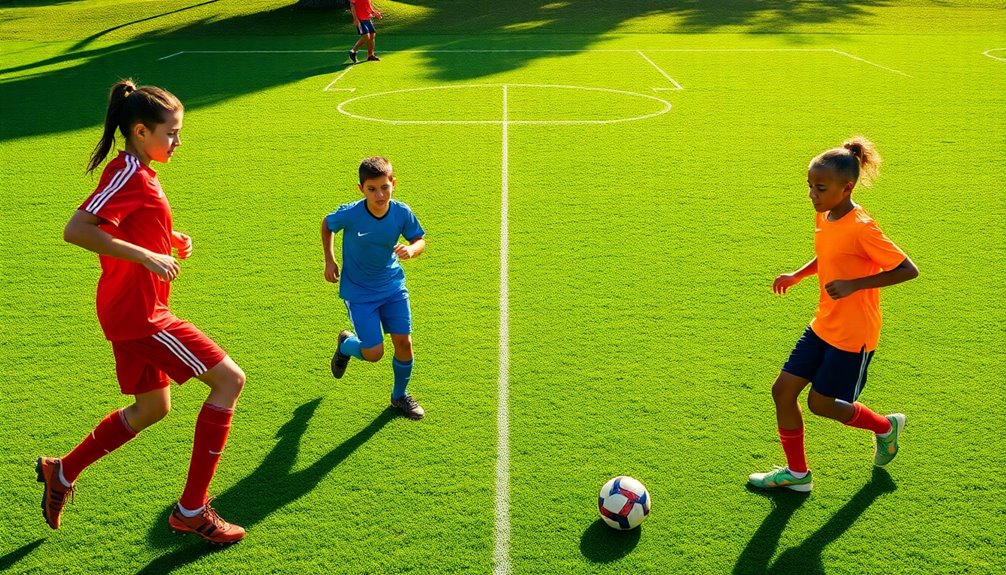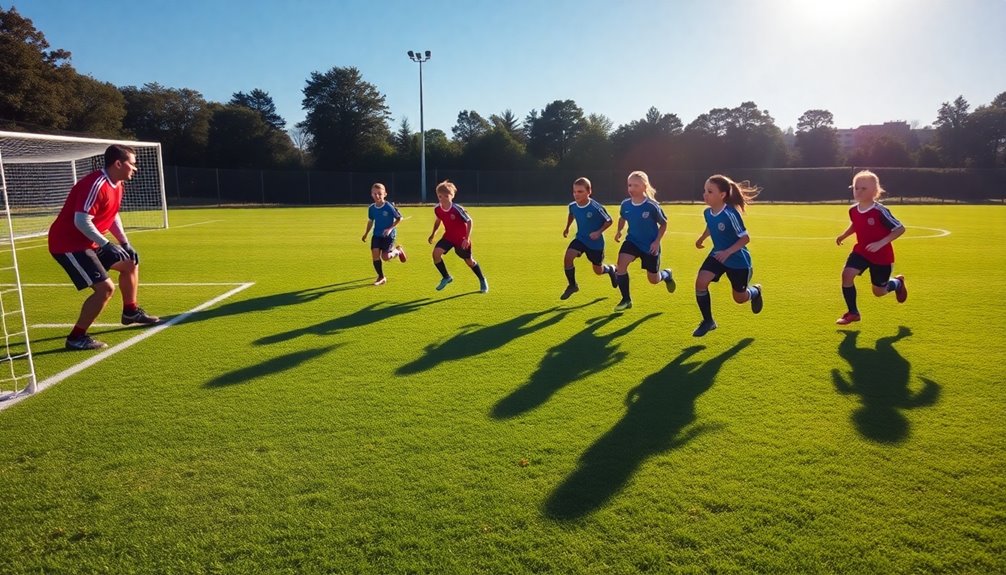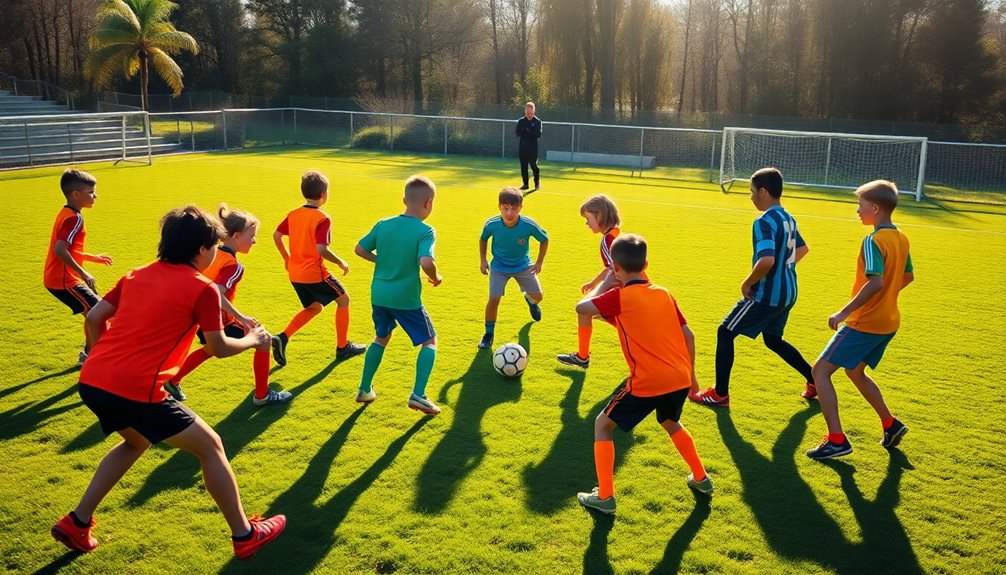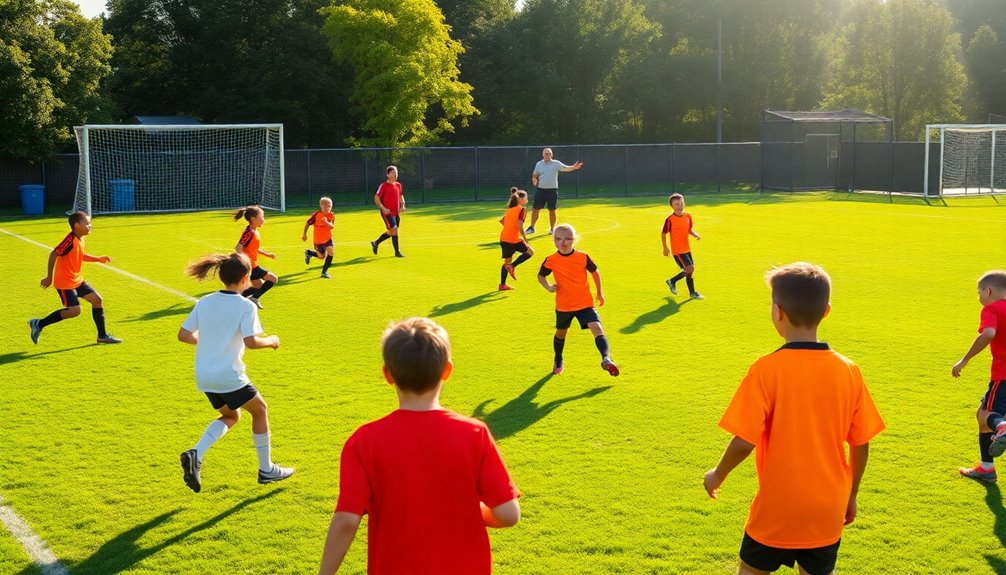
Visualizing Success: Youth Soccer Positions Diagram
February 19, 2025Visualizing youth soccer positions through diagrams is essential for understanding roles on the field. By clearly illustrating player responsibilities, these diagrams enhance teamwork and boost performance. Engaging in mental imagery helps you mentally rehearse different game scenarios, preparing you for various challenges during matches. It also reinforces strategic communication among teammates. Plus, using tools like position diagrams allows you to grasp formations better, improving your tactical awareness and decision-making. If you're curious about how these visuals can further enhance your game strategy, you might find the next sections insightful.
Importance of Visualization
Visualization plays an essential role in enhancing your performance on the soccer field. By engaging in mental preparation through visualization, you can mentally rehearse game situations, helping you to respond more effectively during matches. Spending just 5 to 30 minutes daily on this practice can notably boost your game readiness, as it trains your mind to anticipate various scenarios. Incorporating speed and agility drills into your training routine can further enhance your ability to react during these visualized situations. Additionally, a well-structured conditioning program that includes warm-up routines can optimize your physical readiness for these mental exercises.
When you visualize correctly, you reinforce the correct skills and techniques needed to excel. However, it's vital to guarantee your visualization is accurate. Incorrect visualization can inadvertently reinforce errors, which can hinder your performance.
To maximize the benefits, create a distraction-free environment where you can relax both physically and mentally. This will allow you to focus entirely on your visualization sessions.
Regularly varying your visualization scenarios and perspectives prepares you for the diverse game situations you'll encounter. Whether it's envisioning a defensive move, executing a perfect pass, or scoring a goal, each scenario sharpens your mental acuity. Additionally, incorporating specific soccer moves into your visualization can enhance the effectiveness of your mental practice.
Ultimately, effective visualization not only enhances your skills but also builds your confidence, setting you up for success on the field.
Techniques for Effective Visualization
- Daily Practice: Spend 5 to 30 minutes each day visualizing. This consistent routine helps reinforce skills and mental readiness, essential for peak performance.
- Create a Distraction-Free Environment: Find a quiet space where you can relax both physically and mentally. This clarity enhances the effectiveness of your visualization sessions.
- Vary Your Scenarios: Choose specific skills and visualize different game situations. This prepares you for various challenges on the field, enhancing your overall performance.
- Focus on Positive Imagery: Correct any negative thoughts by concentrating on successful past experiences. This can greatly boost your confidence, making your visualizations more impactful.
- Incorporate Tactical Awareness: Visualizing tactical nuances can help you make better decisions during games, ultimately leading to improved performance on the field.
Steps for Successful Visualization

To achieve successful visualization, start by establishing a structured routine that you can stick to daily. Aim to practice visualization for 5 to 30 minutes, enhancing your mental readiness and reinforcing your skills. Choose a specific time and place that's free from distractions, allowing you to improve your focus and relaxation.
Next, develop a consistent visualization routine by selecting specific skills to work on and various scenarios to mentally rehearse. Picture yourself maneuvering through different game situations, which will prepare you for the unpredictability of actual matches. Engaging in positive visualization experiences is essential; generate successful mental images and actively correct any negative thoughts or errors during practice.
Don't forget to vary the scenarios and perspectives in your visualization sessions. This approach guarantees you're ready for diverse game situations and increases your adaptability on the field.
Additionally, incorporating game intelligence into your visualization can enhance your ability to anticipate opponents' moves and make quick decisions during matches.
Overcoming Common Misconceptions
- Visualization replaces practice: Some believe visualization can substitute for physical skill development. Instead, it should enhance your actual practice, reinforcing the correct techniques for different positions on the field.
- It's too complicated: You don't need complex terminology to grasp visualization. Young players can easily understand the concepts, making it accessible for everyone.
- Visualization is boring: If you see visualization as tedious, it can become unproductive. Approach it as an engaging and enjoyable technique, turning it into a positive mental experience.
- Mastery happens overnight: Visualization requires time and repetition. To truly benefit from it, you need to be persistent and consistent in your practice.
- Integration with practice is key: Incorporating visualization alongside regular drills can enhance your defensive skills and decision-making on the field.
Benefits of Mental Imagery

Mental imagery can be a game-changer for youth soccer players, providing a powerful tool for understanding their positions and responsibilities on the field. By engaging in visualization, you can mentally rehearse game scenarios, which enhances your overall performance. This practice not only boosts your confidence but also helps you maintain focus during high-pressure situations, allowing you to think clearly when it matters most. Visualizing your role as a goalkeeper can improve your shot-stopping skills and decision-making in crucial moments. Additionally, prioritizing quality training sessions ensures that your visualization practice translates into effective gameplay.
When you visualize successful execution of your role, you reinforce positive skills and correct errors in technique, essential for development in positions like goalkeeper or midfielder. A multi-sensory approach, incorporating vivid imagery and emotional engagement, prepares you for various game situations, making you more adaptable on the field.
Moreover, visualization fosters a positive mindset, which is crucial for effective teamwork. As you envision yourself working well with teammates, you build camaraderie and enhance cooperation during matches. Additionally, consistent training and injury prevention techniques are vital to maintaining peak performance while applying mental imagery.
Embracing mental imagery empowers you to take charge of your growth as a player while improving your understanding of how to contribute to your team's success. So, start incorporating visualization into your training routine and watch your skills and confidence soar!
Understanding Youth Soccer Positions
Understanding youth soccer positions is vital for any player looking to improve their game and contribute effectively to their team's success. Familiarizing yourself with different roles not only enhances your skills but also boosts your team's overall performance.
Here are four key points to keep in mind:
- Position Variability: Youth soccer positions can vary based on the team's formation, which may not always include 11 players.
- Roles and Responsibilities: Each position, from goalkeepers to midfielders and defenders, has specific responsibilities tailored to the players' strengths.
- Spatial Awareness: Developing spatial awareness is important. You need to adapt your positioning based on the game's flow and your teammates' movements.
- Visual Aids: Using visual examples, like position diagrams, can help you grasp the concepts of positioning and team formation. These tools are invaluable for grasping your role on the field.
Additionally, understanding how to effectively communicate on the field can significantly enhance your team's performance and cohesion.
Key Player Roles and Responsibilities

In youth soccer, each position carries unique roles and responsibilities that shape the game.
You'll find that understanding the essential traits of players, like the goalkeeper's fearlessness or the attacking midfielder's creativity, is vital for team success. Effective communication in soccer is essential for organizing defensive strategies and ensuring cohesive team play.
Additionally, a solid understanding of communication with teammates can enhance the effectiveness of both defensive and offensive plays.
Let's break down what each role entails and how they contribute to both defense and attack.
Essential Position Traits
Every player on the soccer field has an essential role that contributes to the team's overall success. Understanding the traits required for each position can enhance your gameplay. Here's a breakdown of key position traits:
1. Goalkeeper: You need fearlessness, vocal leadership, and agility. These traits help you thrive in high-pressure situations and keep the ball out of the net.
2. Defenders: Right and left Defenders must excel in 1v1 tackling, showcasing speed to balance both attacking and defensive responsibilities while maintaining the team's width.
Center defenders should be larger and stronger, focusing on organizing the defense and making smart decisions to prevent central penetrations.
3. Central Defensive Midfielder: As a midfielder, you must disrupt the opponent's attack and maintain possession. Your disciplined decision-making is vital for ensuring connectivity between defenders and midfielders.
4. Attacking Midfielder: In this role, creativity and mobility are key. You focus on penetrating the opponent's defense and creating scoring opportunities, primarily operating in the attacking half behind the central forward.
Responsibilities of Each Role
Each position on the soccer field comes with specific responsibilities that are vital for the team's success.
The goalkeeper plays a key role in preventing the ball from entering the goal. You'll need to collect balls on the ground, organize your defense, and showcase mental resilience and vocal leadership.
Center backs focus on organizing the defense and preventing central penetration. You must make smart decisions to avoid losing possession, especially in high-pressure situations.
As a defensive midfielder, your job is to disrupt opponent attacks before they reach the defenders. You'll connect with teammates and maintain possession to guarantee there are no gaps between midfielders and defenders.
On the other hand, attacking midfielders are responsible for penetrating the opponent's defense. You'll use creative passing or dribbling to find space and create scoring opportunities, greatly contributing to offensive plays.
Finally, when playing as a center midfielder, you'll bridge the gap between defense and attack, facilitating the flow of the game.
Embrace these responsibilities, and you'll help your team thrive on the field!
Offensive Position Characteristics
Understanding the characteristics of offensive positions is key to enhancing your gameplay. When you play as a Center Forward, you're not just a player; you're a vital part of your team's attack.
Here are four essential offensive position characteristics to focus on:
- Scoring Opportunities: You need to be constantly on the lookout for chances to score. This means being agile and mobile to navigate through defenders effectively. Successful scoring from free kicks can also provide additional opportunities to increase your goal tally.
- Excellent Positioning: Your positioning is significant. Stay aware of where you're on the field to receive passes and create space for both yourself and your teammates. Proper player positioning is crucial during free kicks and can enhance your overall effectiveness in attack.
- Communication: Teamwork is essential. You must communicate well with midfielders to maximize scoring chances and maintain attacking momentum.
- Aggressive Play Style: Adopt a confident demeanor and an aggressive attitude. This will enable you to capitalize on shot opportunities and lead your team in attacking plays. Additionally, effective communication on the field can enhance your ability to coordinate with teammates during offensive plays.
Coaching Strategies for Development

Effective coaching strategies play an essential role in developing young soccer players, as they focus on each player's specific role and positional play. Instead of chasing the ball, you'll emphasize understanding individual responsibilities, which fosters better teamwork and game awareness.
Structured warm-ups tailored to specific positions enhance players' confidence, especially attackers, improving their scoring opportunities.
To maximize practice efficiency, consider using tools like the Open Goaaal® Soccer Trainer. This keeps the ball in play, allowing you to concentrate on teaching youth soccer positions effectively.
Encourage communication among players about their strengths and weaknesses—this enhances team dynamics and enables better strategic adjustments during games.
Additionally, strategically substituting players is important. Focus on rotating strikers and fullbacks while keeping center backs and midfielders on the field to maintain team structure and performance consistency.
By implementing these coaching strategies, you'll not only develop individual skills but also create a cohesive unit that thrives on the field. Understanding the roles of 11 players on the field is vital for fostering effective teamwork and collaboration among young athletes.
Tools for Effective Coaching
To elevate your coaching game, consider incorporating a variety of tools that enhance both practice efficiency and player development. Here are four vital tools to help you succeed in youth soccer:
- Open Goaaal® Soccer Trainer: This multifunctional tool combines a goal, rebounder, and backstop. It minimizes time spent retrieving balls, allowing players to focus on practicing their positions effectively.
- Structured Warm-Up Sessions: Tailor warm-ups to specific roles, particularly for attackers. This boosts confidence and readiness, emphasizing important scoring techniques.
- Visual Aids: Use position diagrams to improve players' understanding of their roles on the field. These visual aids enhance spatial awareness, which is essential for effective coaching.
- Consistent Substitution Strategy: Implementing a reliable substitution plan helps manage player fatigue while maintaining team dynamics. This guarantees critical roles like center backs and midfielders remain stable during gameplay.
Player Positioning and Substitution Strategies

In youth soccer, player positioning and substitution strategies can make or break a game. A preferred 7v7 formation typically includes 2 center backs, 3 midfielders, 2 fullbacks, and 1 striker. This setup balances offensive and defensive play.
You should place your strongest players as center backs, ensuring effective ball distribution and defensive stability. Center midfielders need to be your most technically skilled players, thriving in tight spaces to maintain control.
When it comes to substitutions, focus on rotating your strikers and fullbacks to manage fatigue effectively. Keep center backs and center midfielders on the field longer to enhance team dynamics and cohesion.
It's essential not to field all your best players at once, as this can disrupt competitive balance; instead, distribute weaker players strategically across positions.
Effective communication about each player's strengths and weaknesses is important for making informed substitutions. By discussing these aspects with your team, you can adapt quickly during matches, ensuring that everyone understands their roles.
Ultimately, thoughtful player positioning and smart substitutions will greatly impact your team's performance on the field.
Conclusion
In the grand tapestry of youth soccer, visualization is your brush, painting pathways to success. By embracing effective techniques and overcoming misconceptions, you'll sculpt not just skilled players, but confident thinkers. Remember, each position on the field tells a story, and your coaching strategies are the ink that brings those tales to life. As you weave mental imagery into practice, watch your team's potential blossom, transforming dreams into dazzling victories. Keep this vision alive, and the game will thrive.


